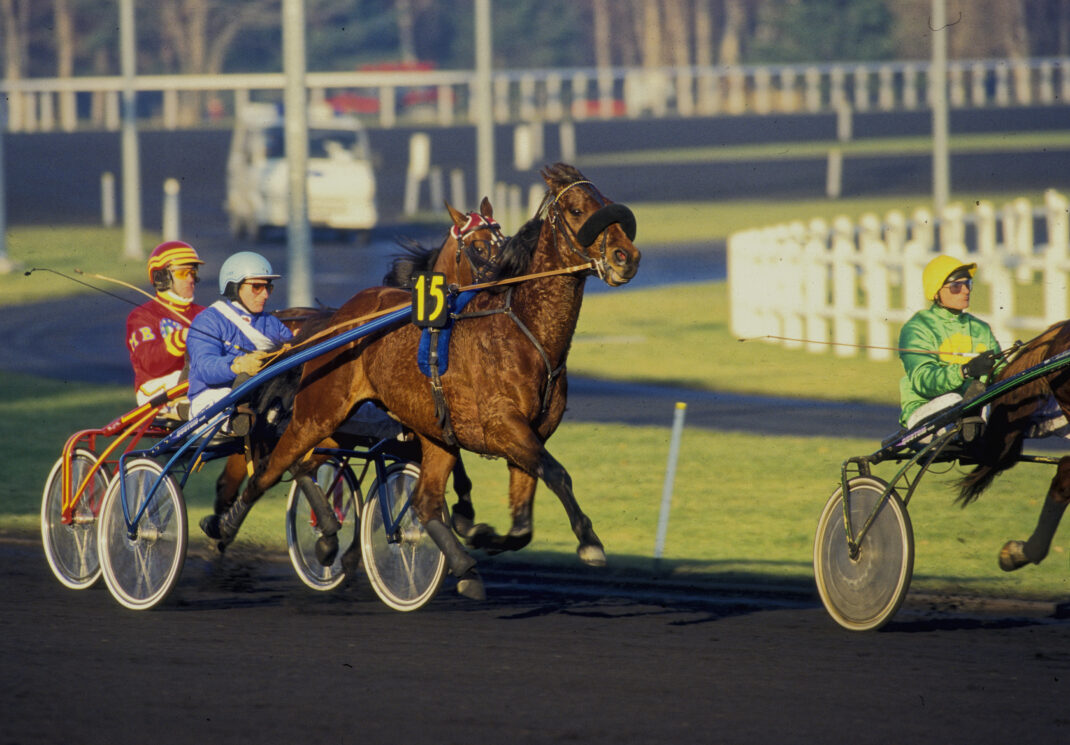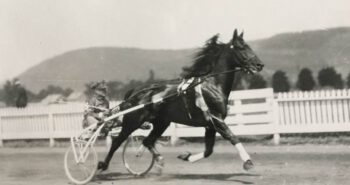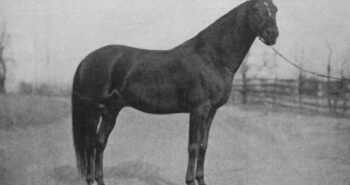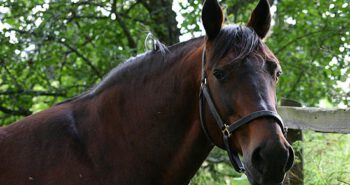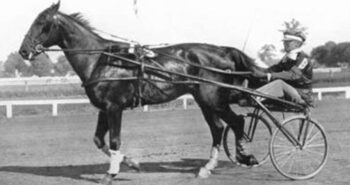When the French studbook was briefly opened between 1987 and 1992, conservative French breeders generally nixed the opportunity to breed their mares to foreign sires. Some even went as far as claiming they “didn’t want to plant weed in their garden”, saying in no unclear terms that the American standardbred had absolutely nothing to offer the French trotter whose studbook had been closed since 1937 and only opened for five foreign-born stallions and a few other exceptions. Despite what the naysayers claimed, though, opening up the studbook took French trotting to a completely new level – and the best example of this is Coktail Jet.
The Franco-American protocol was valid from 1987 to 1991, inclusive, and affected the crops born from 1988 to 1992. It opened up for ten French mares to be bred to non-French stallions, and ten non-French mares to be bred to French stallions, and the foals would qualify for the French studbook. Breeders had to apply in advance and, given that more that 10,000 broodmares are bred annually in France, one might have expected tough competition for these spots – but that was not the case. However, a few bright minds still saw the potential, among them Jean-Pierre Dubois and his family. Dubois owned a few excellent French broodmares, including Nesmile, who was consistently bred to American stallions during this opening in the studbook.
His oldest son, Jean-Etienne, decided to take the reverse approach. He had bought the Canadian/born-Armbro Glamour for $17,000, an amount that Dubois later stated was “all my savings at the time”, at an auction at the Meadowlands in 1988. Even though she was bought by Jean-Etienne there can be no question that Dubois senior played a major part in the decision: he had seen Elma impress at Vincennes in the mid-60s, winning the Prix de France and finishing second to Roquepine in the Prix d’Amerique. Armbro Glamour was out of Speedy Sug, a daughter to a full sister to Elma. In an interview with Province-Course, Jean-Etienne Dubois stated “We selected her from the catalog, with my father, because she was a daughter of the crack Super Bowl, himself by the champion Star’s Pride, and, even more, because she descended from Elma, a champion whom my father had seen running in Europe and who had impressed her. (…) I trained Armbro Glamour a little in the United States before returning to France with her, but she was not good. She was probably made for breeding.”
Breeding by heart
Taking his new broodmare to France, Jean-Etienne Dubois bred her the following year to the young French stallion Quouky Williams. This seems like a strange selection given that Quouky Williams wasn’t that highly regarded, and Dubois later said that the decision “was a choice of heart.” He has, however, also stated that the pedigree of Quouky Williams was a major part of the decision. Quouky Williams was a relatively blue-blooded trotter, a son of Fakir du Vivier and hailing from one of the better French maternal lines. His dam Dolly Williams was third in 1972 Criterium des Jeunes, one of the biggest races for three-year-olds in France. She was also sister to Hase Williams, dam of the great Tidalium Pelo, the only horse in history to win the elusive trio of Prix d’Amerique, Prix de Cornulier and the Elitlopp. And despite sometime derided nowadays, Quouky Williams was not a bad trotter. In fact, he showed talent very early, winning the Prix Louis Cauchois in September as a two-year-old for Jan Kruithof, before finishing second in the Prix Emmanuel Margouty, the biggest race for two-year-old colts in France. He followed up by finishing second to the German star Dizam Speed in the Prix Henri Cravoisier the following year. Quouky Williams died very early and only stood stud for two years in France and Italy but proved himself way above average as those crops contain quite a few good trotters.
A troublesome knee
In an interview with the Swedish magazine Travronden in 1992, when asked to pick out and pose with the most promising two-year-old in his stable, Jean-Etienne brought out Coktail Jet. He was unstarted but Dubois had a very good understanding of his horse’s talent even then. “He was good very early at 2. I hadn’t trained many good horses at the time, but I had seen my father’s horses and I knew I had a special horse, ” Dubois told Province-Course. However, Coktail Jet struggled with a knee at 2 and Dubois was extremely careful not to risk his immense talent. Instead of starting him against the best in the crop, the young trainer gave Coktail plenty of time to develop against easier competition in the beginning. Coktail Jet was 6-2-1 in 9 starts as a three-year-old. In his last start that year, in Prix de Vichy at Vincennes, he defeated Capitole, the winner of the group II race Prix Albert Viel earlier that year.
In the 94 winter meeting Jean-Etienne Dubois started the four-year-old star against the best and despite two mishaps, where he was disqualified, Coktail Jet picked up two second places in the Prix de Selection and Prix Gaston de Wazieres. Dubois then took him to Gran Premio d’Europa at the San Siro track in Milan, Italy, a race previously won by several French horses including Une de Mai, Passionnant and his paternal grandsire Fakir du Vivier. Winning in Italy, he returned home and was one of the favorites for the Criterium des 4 ans. However, the colt broke stride and was disqualified. But Dubois knew it was a one-off and went back to Italy where the duo took home the Gran Premio Citta di Torino ahead of King Lavec.
Meeting the elite
Knowing his young star’s abilities, Dubois did something surprising, he started him in the Group I race Prix Rene Balliere in mid-June. Even though it was not unprecedented for a four-year-old to start there, the race is extremely demanding and always a high-speed event. The 1994 edition was no exception as Sea Cove and Jos Verbeeck shattered the existing race record, winning in 1.12,0 over 2100 meters (1:55.4 over 1 5/16 mile), but Coktail Jet impressed everybody by finishing just a few lengths behind. Despite the proven talent, consistency still evaded the son of Quouky Williams and he only won two of his six remaining races that year. The penultimate race of the year was the French qualification for the Grand Prix de l’UET (the European Derby for four-year-olds), where Coktail Jet again broke stride and was disqualified. But when Cashinga, who was second in that qualifier, pulled out of the final the French association ended up giving her spot to Coktail Jet. Breaking stride again in the final, the colt could only muster a sixth-place finish in the final at Solvalla.
Coktail Jet and Jean-Etienne Dubois enjoyed mixed success in the 1994-95 winter meeting, but after a third-place finish in the Prix du Luxembourg he took four consecutive second places and showed that he was adding consistency to his repertoire. The last of these was a memorable race in the Grand Vitesse at Cagnes-sur-Mer where he narrowly lost to Houston Laukko, timed in 1.11,5 (1:55s) at the fast Mediterranean track. A win in the Prix Henri Levesque was then followed up by a 1.11,8 (1:55.3) win at Argentan in the Criterium de Vitesse de Basse-Normandie. He was disqualified in his next start at Caen, but that was the last dq in his 64-start long career. He finished third in the Prix Chambon P and followed up by winning the Prix Rene Balliere, narrowly missing out on Sea Cove’s race record before winning the Prix de Washington at Enghien, winning in 1.11,2 (1:54.3s), utterly demolishing Express Ride’s old race and track record that stood at 1.12,5 (1:56.3s).
In his first trip to Sweden for the Hugo Åbergs Memorial he “only” managed a fourth place finish but if one looks behind the final position he was extremely impressive. Sitting last with nowhere to go in the last turn, Jean-Etienne Dubois overcame traffic problems and Coktail Jet finished faster than everybody else, but Houston Laukko was too far ahead.
A legendary double
Back in France he notched up wins in the Prix Jockey, Criterium des 5 ans and Prix de l’Etoile before taking a few months off to prepare for the winter meeting. In the Prix d’Amerique, Dubois eased his star from the start, but quickly moved him forward on the outside of the field in the downhill. Before the uphill he was in the lead and Cedre du Vivier pressed him hard in the uphill, but in the final stretch he pulled away, winning by a slightly less than two lengths ahead of Abo Volo. The next week he followed up by winning the Prix de France and later that spring he also took home the Prix de l’Atlantique. In May he went to Solvalla to try to become one of the unique few horses to win the Prix d’Amerique and the Elitlopp in the same year – a feat that then had not been accomplished since 1971 when Tidalium Pelo did it.
In this elimination heat Coktail Jet was again eased out of the gate from post 7 and Dubois also felt he was a bit sluggish. Attacking with a bit more than a quarter to go, he got to the final with the slimmest of margins, narrowly taking the fourth place ahead of the Finnish gelding Isla J Brave. Many observers felt that Dubois had made the mistake of attacking too late, though. In the final Coktail Jet was again eased slowly from the start and sat pretty in last place in the backstretch. While the Swedish commentator screamed that “Dubois has to do something here” the French trainer-driver didn’t feel in a hurry as he waited to attack until the field went into the last turn. It had not paid off in the elimination, but Dubois felt his horse was much better in the final and was still confident. Attacking with a quarter to go, Coktail Jet showed that the new generation of French trotters are not only strong, but also exceptionally speedy, as he flew by the field down the final stretch, winning comfortably by more than a length. The 27-year-old Jean-Etienne Dubois and his 6-year-old superstar had managed to win the Prix d’Amerique and Elitlopp double, a feat only achieved by 7 horses in history by then (later Varenne did this twice, too).
Back in France he again won the Prix de Washington and then Prix d’Europe before he set his sight on something no European horse had won before, the Breeders Crown in the US. Despite being in great form and even made the favorite by the Meadowlands crowd, on that day he met his match in the freakishly good CR Kay Suzie who showed her superiority when winning in 1.10,0 (1:52.3). Coktail Jet finished sixth, timed in 1.10,7 (1:53.4), but was never in the race.
Back in France, he targeted another Prix d’Amerique win, finishing second in the Prix d’Ete and then third in a race at La Capelle before Dubois again withdrew him for two months ahead of the winter meeting. Finishing second and seventh in the warm-up races, without being driven to win, Coktail Jet disappointed by finishing seventh in the Prix d’Amérique. When he finished sixth in the Prix de France a week later, Jean-Etienne Dubois took one look at his star and decided to retire him to stud full time. In an interview with Equidia after the colt’s death, Dubois pointed to the trip to the Breeders Crown as the catalyst for his retirement: “He was knocked out by the humid heat in New York and was never the same after that trip and race. It was over. He ran again until the Prix de France of the following year before devoting himself completely to his stud career.”
A legendary stallion
Coktail Jet was French champion stallion 7 times and his get has won numerous top races all over Europe and even in the US (Papagayo E won the 2015 International Trot). A total of 27 sons and daughters have won a group I-race, counting both national and international races, in Europe (Amaru Boko, Classico Merett, Cristal Money, El Toro BR, Enino du Pommereux, First Eleven L, Gu d’Heripre, Hard Times, Island Dream, Jain de Beval, Jetstile, Kerido du Donjon, Kiwi, Look de Star, Love You, Lucky d’Hilly, Magnificent Rodney, Makhtoub Jet, Naglo, Nelson November, Nice Love, Papagayo E, Quif de Villeneuve, Saxo de Vandel, The Best Madrik, Union d’Urzy and Yarrah Boko), and more than 100 sons and grandsons currently stand stud all over Europe.
His daughters has also done exceptionally well at stud. Coktail Jet is the damsire of stars such as Cokstile (winner of numerous group I-races in Europe as well as the International Trot), Bilibili (double Prix de Cornulier-winner), Perland (euro-millionaire and multiple group II-winner), Texas Charm (one of few trotters to win a group I-race in both monte and sulky), Moni Viking (multiple group I-winner, three world records over longer distances), Dijon (Elitlopp-winner), Napoleon Bar (multiple group I-winner in Italy), Infinitif (winner Italian 2008 Derby, best known in America as the sire of Ecurie D) and sibling duo Gunilla d’Atout and Krack Time Atout, both group I-winners.
In short: Coktail Jet’s influence is absolutely massive and will not diminish anytime soon. His bloodline, descending from the legendary Sam Williams, is also back in the US thanks to his paternal grandsons International Moni and Rattle My Cage.
The legendary French trotter died from a heart attack on Dec 13, 2018, 28 years old.
Coktail Jet
Bay colt born in Belfonds, France on Apr 29, 1990. Died in Belfonds, France on Dec 13, 2018.
Quouky Williams – Armbro Glamour (Super Bowl)
64 starts: 24-12-5 – Fastest win: 1.11,2 (1:54.3) – Fastest time: 1.10,7 (1:53.4) – €1,896,774
Breeder: Jean-Etienne Dubois
Owners: Jean-Etienne Dubois – Daniel Wildenstein
Trainer: Jean-Etienne Dubois
Driver: Jean-Etienne Dubois
Groom: Ludovic Leberton

